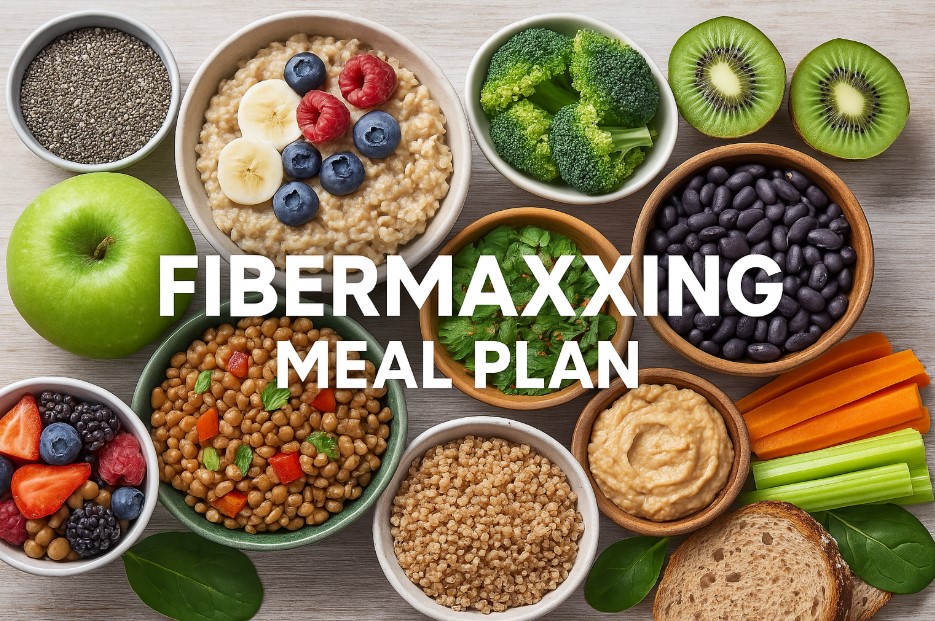Health
Fibermaxxing Meal Plan: What to Eat in a Day

Fiber plays an essential role in maintaining a healthy digestive system, regulating blood sugar levels, and supporting heart health. The term “fibermaxxing” refers to intentionally increasing your fiber intake to improve overall well-being. This practice has become popular among health-conscious individuals looking to optimize digestion, promote satiety, and support long-term health. While it is simple in concept, fibermaxxing requires careful meal planning to ensure a balanced diet that avoids discomfort or digestive distress. This article outlines a practical daily meal plan that helps you reach higher fiber targets safely and effectively.
Understanding Fibermaxxing
Fibermaxxing means maximizing your daily fiber intake through whole, natural foods rather than supplements or processed products. It involves consuming both soluble and insoluble fibers in sufficient amounts to promote digestive regularity and support gut health. Soluble fiber dissolves in water and helps regulate cholesterol and blood sugar, while insoluble fiber adds bulk to stool and aids in bowel movement.
The recommended daily intake of fiber is about 25 grams for women and 38 grams for men. Fibermaxxing may increase these numbers slightly, but it should always be done gradually to prevent bloating or discomfort. A proper plan balances fiber-rich foods with adequate water and nutrient-dense meals to ensure overall health.
Benefits of Fibermaxxing
A fiber-rich diet offers many health benefits, including improved digestion, reduced risk of chronic diseases, and better weight management. The main advantages of fibermaxxing include:
- Improved digestive health: Fiber supports regular bowel movements and helps prevent constipation.
- Better blood sugar control: Soluble fiber slows the absorption of sugar, promoting stable energy levels.
- Heart health support: Fiber can lower LDL cholesterol, reducing cardiovascular risk.
- Enhanced satiety: High-fiber foods keep you fuller for longer, which can support weight management.
- Gut microbiome balance: Fiber feeds beneficial gut bacteria, contributing to overall digestive balance.
To gain these benefits, consistency is key. The following one-day fibermaxxing meal plan shows how to structure your meals for optimal results.
A One-Day Fibermaxxing Meal Plan
The goal of this sample plan is to help you reach around 35 to 40 grams of fiber in a balanced way. Each meal includes a combination of complex carbohydrates, protein, and healthy fats to maintain nutritional harmony throughout the day.
Breakfast: High-Fiber Oat Bowl (10–12 grams of fiber)
Start your day with a simple yet effective breakfast designed to boost energy and provide lasting fullness. Oats are a powerful source of soluble fiber, while fruits and seeds add additional nutrients.
Ingredients:
- ½ cup rolled oats
- 1 cup unsweetened almond milk or low-fat milk
- 1 tablespoon chia seeds
- ½ sliced banana
- ¼ cup mixed berries
- 1 teaspoon honey or natural sweetener
Preparation:
Cook the oats in milk until soft, then top with banana, berries, and chia seeds. Add a drizzle of honey for sweetness.
Why it works:
This meal provides a combination of soluble and insoluble fiber, slow-digesting carbohydrates, and antioxidants. Chia seeds and berries add texture and enhance digestive support.
Mid-Morning Snack: Apple and Almonds (6–7 grams of fiber)
For a light snack, pair one medium apple with 10 to 12 raw almonds. Apples provide pectin, a type of soluble fiber that supports healthy digestion, while almonds offer protein and healthy fats.
Tip: Keep the apple peel on, as most of the fiber is found in the skin.
Lunch: Lentil and Quinoa Salad (12–14 grams of fiber)
A fibermaxxing lunch should include plant-based proteins and grains. Lentils and quinoa are excellent sources of both fiber and essential amino acids.
Ingredients:
- ½ cup cooked green lentils
- ½ cup cooked quinoa
- 1 cup mixed vegetables (such as cucumber, bell peppers, and spinach)
- 1 tablespoon olive oil
- Lemon juice and herbs for flavor
Preparation:
Combine lentils, quinoa, and vegetables in a bowl. Toss with olive oil, lemon juice, and your preferred seasoning.
Why it works:
This dish delivers a steady source of energy, keeps blood sugar stable, and contains both soluble and insoluble fiber for balanced digestion. The inclusion of olive oil adds healthy fats that improve nutrient absorption.
Afternoon Snack: Carrot Sticks with Hummus (5–6 grams of fiber)
Carrots are rich in insoluble fiber, while hummus (made from chickpeas) provides additional fiber and protein. A serving of about eight carrot sticks with three tablespoons of hummus makes a satisfying snack.
Tip: If you prefer variety, substitute carrots with celery or bell pepper strips.
Dinner: Black Bean and Vegetable Stir-Fry (10–12 grams of fiber)
Dinner is an opportunity to finish your day with a meal that’s filling yet light. Beans are among the best sources of dietary fiber and plant-based protein.
Ingredients:
- ½ cup cooked black beans
- 1 cup mixed vegetables (broccoli, zucchini, and red peppers)
- 1 tablespoon olive oil
- 1 teaspoon soy sauce or low-sodium seasoning
- Brown rice or quinoa as a base (½ cup cooked)
Preparation:
Sauté the vegetables in olive oil until tender. Add black beans and seasoning, then serve over brown rice or quinoa.
Why it works:
This meal combines plant-based protein, slow-digesting carbohydrates, and high fiber content to promote fullness and support overnight digestion.
Evening Snack: Greek Yogurt with Flaxseeds (4–5 grams of fiber)
End the day with a small but nutritious snack. Mix one cup of Greek yogurt with one tablespoon of ground flaxseeds. Add a few slices of kiwi or berries for flavor. This provides probiotics for gut health and fiber for digestive balance.
Tips for Successful Fibermaxxing
Increasing fiber intake should be done mindfully. A sudden rise in fiber consumption can cause bloating, gas, or discomfort. Follow these tips to ensure a smooth transition to a fibermaxxing diet:
- Increase intake gradually: Add fiber-rich foods slowly over several days or weeks.
- Stay hydrated: Drink plenty of water, as fiber absorbs liquid during digestion.
- Balance soluble and insoluble fiber: A mix of both types supports healthy digestion.
- Include a variety of sources: Rotate between fruits, vegetables, legumes, nuts, and grains.
- Listen to your body: Adjust portion sizes if you experience discomfort.
Fiber Content Reference Table
To plan your meals effectively, it helps to know the approximate fiber content of common foods. The table below provides a quick guide to fiber-rich options from different food groups.
| Food Item | Serving Size | Fiber (grams) |
| Rolled oats | ½ cup (dry) | 4 |
| Apple (with skin) | 1 medium | 4 |
| Banana | 1 medium | 3 |
| Lentils (cooked) | ½ cup | 8 |
| Quinoa (cooked) | ½ cup | 2.5 |
| Black beans (cooked) | ½ cup | 7.5 |
| Chickpeas (cooked) | ½ cup | 6 |
| Chia seeds | 1 tablespoon | 5 |
| Flaxseeds (ground) | 1 tablespoon | 3 |
| Broccoli | 1 cup (chopped) | 5 |
| Carrots | 1 cup (raw) | 3.5 |
| Almonds | 1 ounce (23 nuts) | 3.5 |
| Brown rice (cooked) | ½ cup | 1.5 |
| Berries (mixed) | ½ cup | 4 |
This table can serve as a foundation for planning meals or making substitutions in your daily diet. For example, if you prefer variety, you can replace quinoa with barley or switch from black beans to kidney beans while maintaining a similar fiber intake.
Tracking Your Fiber Intake
When practicing fibermaxxing, monitoring your daily intake is important. Too little fiber reduces the benefits, while too much too quickly may cause discomfort. The goal is to find a sustainable balance.
There are several ways to track fiber intake effectively:
- Use a nutrition app: Apps like MyFitnessPal or Cronometer allow you to log meals and automatically calculate fiber content.
- Keep a simple journal: Write down what you eat each day and refer to a fiber chart to estimate intake.
- Check food labels: Packaged foods list fiber per serving, which makes tracking easy.
- Use portion awareness: Over time, you’ll become familiar with the approximate fiber in your usual meals.
Most people find that small adjustments, like replacing white rice with brown rice or adding a handful of vegetables to each meal, can make a big difference over time.
Common Mistakes When Fibermaxxing
While increasing fiber intake offers significant benefits, there are common mistakes that can reduce its effectiveness or cause discomfort. Understanding these helps maintain balance.
- Increasing fiber too quickly: A sudden jump in intake can lead to bloating, gas, or cramps. It’s better to add fiber-rich foods gradually over one to two weeks.
- Not drinking enough water: Fiber needs water to move smoothly through the digestive system. Insufficient hydration can lead to constipation.
- Relying on supplements: Whole foods provide not just fiber but also vitamins, minerals, and antioxidants. Supplements should only be used if advised by a healthcare professional.
- Ignoring food variety: Relying too heavily on one or two high-fiber foods can create imbalance. Different foods provide different types of fiber and nutrients.
- Skipping protein and fat: Fiber works best in a balanced diet. Including healthy fats and proteins ensures steady energy and improved nutrient absorption.
Avoiding these pitfalls ensures that fibermaxxing remains a positive and sustainable part of your health routine.
Adjusting for Individual Needs
Everyone’s digestive system is different, so it’s important to personalize your fibermaxxing approach. Some people may tolerate higher fiber intake easily, while others may need to adjust more gradually. If you have digestive conditions such as irritable bowel syndrome (IBS), start with moderate increases and monitor your response.
For those focusing on weight management, fibermaxxing can support appetite control by promoting fullness. For athletes, balancing fiber with higher protein and carbohydrate needs helps maintain performance while still supporting digestive health.
If you experience persistent discomfort, consider consulting a dietitian to determine the right fiber balance for your lifestyle and activity level.
Example Adjustments for Different Goals
- Weight management: Focus on high-volume, low-calorie fiber sources like vegetables, beans, and fruits.
- Heart health: Prioritize soluble fiber sources such as oats, flaxseeds, and lentils.
- Digestive health: Combine both soluble and insoluble fiber from whole grains and vegetables to promote regularity.
- Balanced energy: Include fiber-rich whole grains with lean proteins and healthy fats to maintain stable energy throughout the day.
By tailoring your intake, you can optimize fiber benefits for your specific needs without overcomplicating your meals.
Hydration and Fiber Balance
Water intake is essential in a high-fiber diet. Aim for at least eight to ten glasses of water per day, depending on your activity level and climate. When fiber absorbs water, it swells and softens stool, which aids in healthy digestion. Without sufficient fluids, however, fiber can have the opposite effect and lead to constipation or bloating. Herbal teas and water-rich foods like cucumbers and oranges can also support hydration.
How to Make Fibermaxxing Sustainable
Sustainability in nutrition means creating habits you can maintain long-term. Fibermaxxing is not a temporary challenge but a lifestyle adjustment that supports overall health. To keep it sustainable:
- Plan meals ahead: Preparing fiber-rich meals in advance helps you stay consistent.
- Rotate foods weekly: Changing up your sources prevents monotony and improves nutrient diversity.
- Include enjoyable foods: High-fiber eating doesn’t have to feel restrictive; fruits, smoothies, and whole-grain snacks can make it enjoyable.
- Track progress: Notice improvements in digestion, satiety, or energy levels over time.
Gradual and consistent improvement is better than rapid, uncomfortable changes.
Final Thoughts
Fibermaxxing is a practical approach to improving health through diet. By focusing on whole foods like legumes, fruits, vegetables, seeds, and grains, you can significantly increase your fiber intake in a natural way. The sample meal plan provided offers a balanced framework that can be adjusted for personal preferences or dietary needs.
When done correctly, fibermaxxing supports digestion, heart health, weight management, and overall wellness. Remember to increase fiber gradually, stay hydrated, and maintain a balanced intake of nutrients. Over time, these habits become an effortless part of your lifestyle, leading to better health and long-term satisfaction with the way you eat.
-

 Tech2 months ago
Tech2 months agoBest AI Tools for Image Generation in 2025
-

 Food2 months ago
Food2 months agoHard Salami: History, Taste, and How It’s Made
-

 Home Improvement2 months ago
Home Improvement2 months agoThe Benefits of Adding a Bench to Your Living Room
-

 Real Estate2 months ago
Real Estate2 months ago6 Amenities Every Community with 55+ Active Adult Homes in Nashville Should Have






